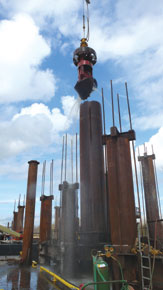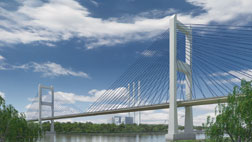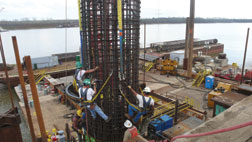 Angelle Bergeron/ENR
Drilled shafts will support North America�s longest cable-stayed bridge.
|
The 1,583-ft main span of the John James Audubon Bridge will be the centerpiece of an overall $403.5-million project that includes a new river crossing between New Roads and St. Francisville, La., and 12 miles of road-way approaches from La. 1/10 to the west and Hwy. 61 to the east.
The joint-venture contractor, Audubon Bridge Constructors (ABC), broke ground in May 2006, after decades of planning by the state. “We could probably dig around and find a report with 1978 on it,” says Chuck Duggar, project manager for Louisiana TIMED Managers (LTM), performing quality assurance for the Louisiana Dept. of Transportation and Development.
In 1989, the bridge plan received the break it needed. The Louisiana legislature created a funding stream for 16 infrastructure projects through the Transportation Infrastructure Model for Economic Development. In 2002 the project was awarded to LTM, which is taking that revenue stream and bonding against it to accelerate construction, Duggar says. When the legislature approved the design-build delivery method in 2004, the bridge project was on its way.
Because DOTD originally had planned to design, build and bid the project, a wealth of information was available to design-builders, Duggar says. “Early on, the department looked at different options for the superstructure. They knew they had to have about a 1,400-ft minimal span, and that meant a cable- stayed or through-truss type of bridge.”
Before the design-build contract was let, DOTD established three criteria: the bridge would be cable-stayed; it must provide necessary vertical clearance at the river and levee and for a rail crossing; and it had to fit within the existing right-of-way.
 Louisiana Dept Of T&D
Louisiana cable-stayed span will surpass Ravenel Bridge as North America’s longest.
|
Flatiron Constructors Inc., Longmont, Colo., is lead partner in the ABC joint venture, which also includes Granite Construction Inc., Watsonville, Calif., and Parsons Transportation Group Inc., Washington, D.C. Flatiron brings its design-build experience with the Arthur Ravenel Jr. (Cooper River) Bridge in Charleston, S.C., which has a 1,546-ft-long main span. “A bunch of Louisiana DOTD folks came out to visit Cooper for a day or two,” says Terry Poole, vice president of operations for Flatiron. “I met with those folks and gave them a presentation with what we do with design-build.”
ABC’s $347.9-million contract is for the main river crossing, approaches and 12 miles of roadway, including seven bridges and a railroad spur that will serve a coal-fired powerplant. Design-build will shave an estimated nine to 10 months off the 42-month contract. It is scheduled for completion on April 28, 2010, with late penalties of $9,210 per day.
 Angelle Bergeron/ENR
Steel casings and German oscillators help in construction of massive footings.
|
Design-build also provides the flexibility required when working with the unpredictable fluctuations in flow and levels of the Mississippi River, Poole says. To maintain access to the work area regardless of water levels, the contractor constructed a temporary trestle on both sides of the river.
Parsons designed the bridge to last 100 years and withstand barge impacts, hurricane winds and scour. The bridge is being built on drilled shafts that showcase more modern technology than typical caisson construction, Duggar says. ABC placed 8-ft-diameter steel casings for the two groups of 21 shafts that will support each footing for the twin 500-ft-tall H-frame pylons. The casings are arranged in three rows of seven and are driven to depths of 180 ft on the east bank and 175 ft on the west.
ABC purchased German-made oscillators that alternate between driving and twisting to place the casings, says Frank Daams, deputy project manager for ABC. Each oscillator has a 500-ton uplift force and oscillates with 5,200-ft kips. “It takes 14 to 16 hours to drive a shaft on the east side and about 30 to drive one on the west,” Daams says.
ABC will next construct a sacrificial concrete cofferdam offsite to pour the footings. Once all the shafts are placed, the cofferdam will be hung, a seal slab poured and metal sheet pile more than 50 ft long will be added to protect from river overflow, says Sereno Brown, ABC project engineer. Soils in the riverbed are not very good for the first 75 ft, Brown notes. Building a permanent cofferdam would have been cost-prohibitive since the contractor would have to go so deep. Each footing will be 160 ft long and 80 ft wide and rise 18 ft above the water. They each require 6,000 cu yd of concrete.
By August, ABC will begin construction on the first of the pylons. The cable-stayed portion of the bridge from expansion joint to expansion joint, is 3,186 ft. The center span, the length that gives the bridge distinction, is 1,583 ft. Buckland and Taylor Ltd., Vancouver, B.C., is the designer.
One of the lessons learned from the Cooper River Bridge is the importance of storing the steel-cable strands indoors, Poole says. ABC purchased a seven-acre property in New Roads to establish site offices and house the galvanized steel strands that will comprise the stay system. The Spanish strands are making their U.S. debut.
“It is a dream to have a strand of this quality,” says Dante Lius, LTM resident engineer. On the Cooper River bridge, because the project was financed by the Federal Highway Administration, “we had to buy American.”
Seven galvanized strands are braided together to comprise one strand at 0.68-in. diameter, Lius says. That strand is protected by wax and encased in a polyethylene jacket.
At 830 ft, the longest of the 136 cables will be made of the cables 69 strands braided together. Each cable will be bound in a polyethylene pipe lined with a carbon liner.
istory is taking root in rural Louisiana with construction of what will be the longest cable-stayed bridge in the Western Hemisphere—and the only drilled-shaft supported bridge in the lower reaches of the Mississippi River. “The pipe will protect the cable strands from ultraviolet rays and wind vibrations,” Lius says. The exterior helix design will discourage puddling and consequent vibrations at the connections, Duggar adds.


Post a comment to this article
Report Abusive Comment